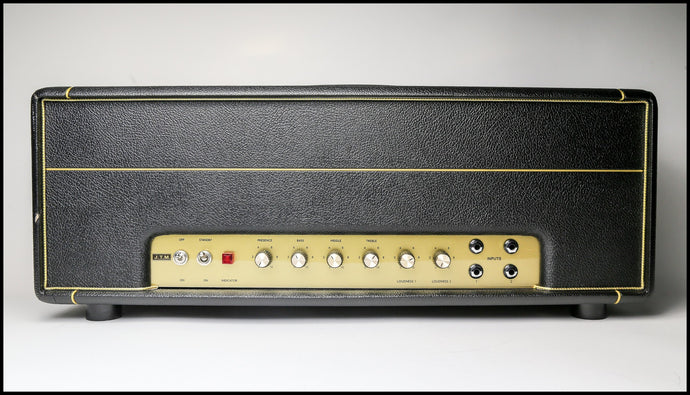The Black Flag JTM50 is a rather rare and coveted after amplifier made by Marshal between 1966 and 1967. It was one of the transitional steps between the JTM45 amps and the plexi panel JMPs and later metal faces. During the short period of time it was produced, the JTM50 saw a few important spec changes that would be a precedent for further development of the Marshall guitar amps.
 Original Black Flag JTM50. Source
Original Black Flag JTM50. Source
It’s important to note that while those recognizable aesthetic features such as markings on the front and back panels or the nicknames that were coined for such amps in recent years may serve to help identifying amps of certain eras, they are not factual indication of the circuit or specs in a particular amplifier. Marshall was still very inconsistent back then and spec changes happened gradually, or probably depended on whether or not they still had certain components in stock.
Marshall started building amps in 1962. Their first model was called JTM45, a copy of (or inspired by) the Fender Bassman. JTM stands for Jim and Terry Marshall, Terry being Jim’s son)
At some point, Marshall started to offer 3 versions of the JTM45 – Lead, Bass and PA. The difference between them were minimal – a few capacitors or resistors maybe. Other models were introduced later.
The amps initially had 5881 power tubes. If not available, 6L6s were used. By 1964, they were changed to KT66s. All of them had the GZ34 rectifier tube.

’65 JTM45. Lead model
according to the poster. Note the GZ34 rectifier tube on the right corner of the chassis. Source

’65 JTM45. Same amp
as above. Source
In 1965, the combo amps (known as Bluesbreaker amps) were introduced. This prompted Marshall to start designating model numbers to keep track of all the models they were producing. They were all still part of the JTM series.
Notable ones include:
1985: PA Model
1986: Bass Model
1987: Lead Model
1989: Organ Model
1961: 4×10 Lead Combo (used the 1987T Lead chassis with Tremolo)
1962: 2×12 Lead and Bass Combo (THE Bluesbreaker
amp, as used by Clapton – had the 1986T Bass chassis with Tremolo)
1963: 50w Super PA Model (8 inputs)
By early ’66 some amps, notably the PAs, began to be called JTM50s instead, probably due to marketing strategies and improvements in the transformer specifications and the resistors used.
 ’65-’66 Marshall Super PA Model #1963 SN 6606. JTM50 on the
front panel. Source
’65-’66 Marshall Super PA Model #1963 SN 6606. JTM50 on the
front panel. Source
 Same amp as above. Note: KT66 tubes. GZ34 rect. tube on the far
right. Source
Same amp as above. Note: KT66 tubes. GZ34 rect. tube on the far
right. Source
Change to EL34s took place around 1966, because they were more plentiful and cheaper – at which point all the amps were rated at 50w and justified the new name.

’66 JTM45 with EL34 power tubes – hard to say if they are
original, but possible given the timeframe. Source

’66 JTM45. Same amp as above. Source
The small spec changes and the switch to EL34s made these early 50w amps brighter and more aggressive than the early JTM45s, but the GZ34 rectifier tube still made them retain some of the ‘softer’ response.

’67 JTM50. EL34 power tubes and GZ34 rectifier
tube. Source
By mid 1967, the ‘JTM50/JTM45’ and ‘MKII’ markings on the front panel were replaced with a characteristic black screen-printed JTM marking on the left side, next to the switches. This was to be known as the “Black Flag JTM”

Original ’67 Black Flag JTM50. Source
During the development of the 100w amps, Marshall decided that the GZ34 rectifier tube wasn’t necessary. The first 100w heads were already made with solid state rectifier. This practice was to be adopted in the 50w amps later on. During this period, a Black Flag JTM50 could either have the GZ34 tube or be SS rectified. It wasn’t until later in 1967 that all the amps were SS rectified.

JTM50 with SS rectifier – it has a second filter cap where the GZ34
would be. Source
SS rectifier give these amps a tighter and faster response.
Soon after, in 1968, the Black Flag marking was replaced by JMP, which stands for Jim Marshall Products.
Also during this period, the 1987 Lead and 1959 Super Lead model circuits were updated. Shared cathode was replaced with split cathode and the tone stack was changed, among other things. These changes made the Lead amps a lot more midrangy and biting. These became what we know today as the classic Marshall rock amps.
The other Models, namely the 1986 Bass and 1992 Super Bass, retained their original circuit with EL34s and SS rectifier even after the change to the JMP era, but because component tolerances and other spec changes took place throughout the years, especially concerning power and output transformers, their tone also would change slightly.
In summary, the Black Flag JTM50 generally has the following specs (not getting into details):
– Shared cathode;
– JTM type tone stack;
– EL34 power tubes (50w);
– GZ34 tube or SS rectifier;
– Bright
cap on Vol I (on 1987 Lead model).
Even though the JMP version seems to be more popular, the Black Flag JTM50 certainly has its place in the history of Rock ‘n’ Roll.
And to close this, an addendum from Fil.
Shown here, a few Angus Young’s (of AC/DC) own JTM50s.
 The caption from the picture is clearly wrong, as the black flag
faceplate indicates that head to be a ’67 Marshall –
The caption from the picture is clearly wrong, as the black flag
faceplate indicates that head to be a ’67 Marshall –
It’s a JTM50, not a JTM45.
And we have to stress once again that Black Flags do NOT have KT66s. As explained earlier, Marshall switched to EL34s in ’66 and the Black Flags only appeared in ’67.
A few more older pics, probably from the 90s:

Look closely at the power tube/rectifier
configuration.
Despite what was always believed – and precisely – that these were JTM45, our research (and pictorial evidence) has
shown that these were always JTM50s. These, particularly (shown), were two reissue JTM45s that were used as a cheap
and convenient way for AC/DC to carve JTM50s out of them. Older and original JTM50s of Angus’ have been seen
previously in older pictures (shown above). These were for live use. The only JTM45s in authentic JTM45
configuration were used on Ballbreaker and Stiff Upper Lip.
For all the rest of the work, since Highway To Hell
in 1979, JTM50s were always used.
Fil SoloDallas
Reference read: The History of Marshall: The Illustrated Story of “the Sound of Rock” by Michael Doyle
Note: Pictures taken from the internet for illustration purposes only. If you own any of those pictures and do not want them featured here, please contact us and they will be removed.





